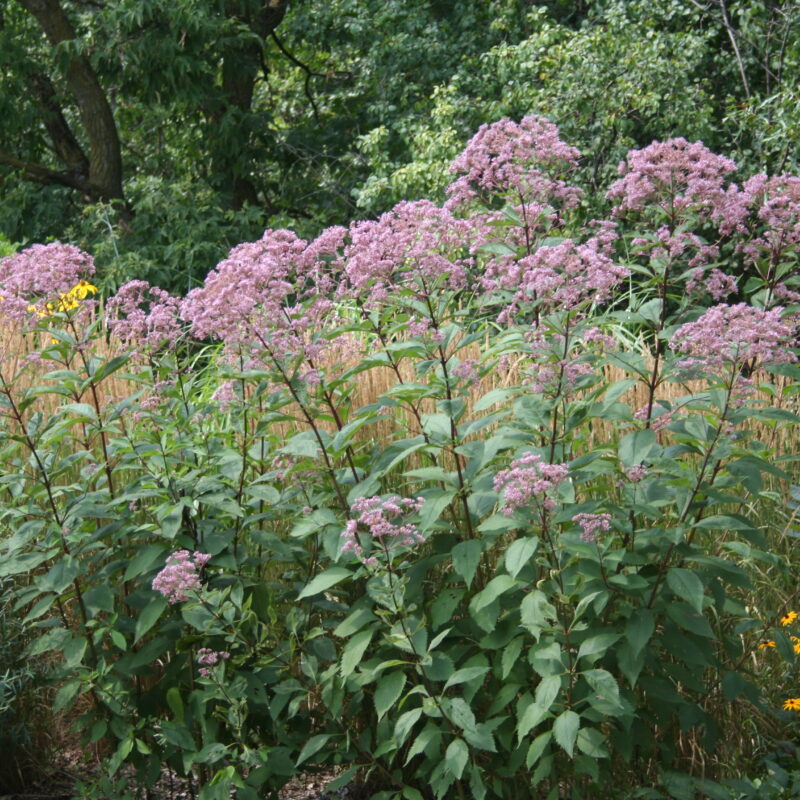Joe-Pye WeedEupatorium maculatum
a.k.a. Eutrochium maculatum
Robust, native perennial herb, usually 1-3' tall with 1 to several stems. Used in restorations, vegetated swales, shorelines, lake edges, wet prairies and gardens. It is an attractive plant, well suited for the perennial garden, rainwater garden and landscape where height is allowed. It prefers calcareous and heavy soils and is usually a good addition to a prairie garden. This species may become aggressive, which may be preferable in some situations. Also, many cultivars or varieties are available, which may work in a landscape design but are not well suited to restorations.
USDA symbol: EUMA9
General Information
| Plant Type | Forb |
|---|---|
| Height | 5 to 6 feet |
| Light Exposure | Sun, Part Sun |
| Soil Moisture | Medium |
| Bloom Color | Pink |

Tolerances
| Flooding / Inundation Tolerance | High |
|---|---|
| General Resilience | 8 |
| Salt Tolerance | Low |
| Stress Tolerance | General Disturbance |
Pollinator Value: Very High
| Bloom Months | August to September |
|---|---|
| Larval Host of | Moths |
| Specific Pollinators Hosted | Oidaematophorus eupatorii, Phragmatobia fulginosa, Schinia trifascia |
| Pollinator Benefit | Insect Pollinated, Provides Nectar, Supports Generalists |
Project Planning
| Project Type | Boulevard, Erosion Control, Rain Garden, Restoration, Sandy or Engineered Soils, Shoreline Buffer |
|---|---|
| Herbivore Sensitivity | Low |
| Lifespan | Perennial |
| Rate of Spread | Slow |
| Soil Stabilization | Shallow |
| Vegetative Reproduction | Clonal |
Range
| County | Aitkin, Anoka, Becker, Beltrami, Benton, Big Stone, Blue Earth, Brown, Carlton, Carver, Cass, Chippewa, Chisago, Clay, Clearwater, Cook, Cottonwood, Crow Wing, Dakota, Dodge, Douglas, Fillmore, Goodhue, Grant, Hennepin, Houston, Hubbard, Isanti, Itasca, Jackson, Kanabec, Kandiyohi, Kittson, Koochiching, Lac qui Parle, Lake, Lake of the Woods, Le Sueur, Lincoln, Lyon, Mahnomen, Marshall, Martin, Mille Lacs, Morrison, Mower, Murray, Nicollet, Nobles, Norman, Olmsted, Otter Tail, Pennington, Pine, Pipestone, Polk, Pope, Ramsey, Red Lake, Redwood, Rice, Roseau, Scott, Sherburne, Sibley, St. Louis, Stearns, Steele, Stevens, Swift, Todd, Traverse, Wabasha, Wadena, Waseca, Washington, Wilkin, Winona, Wright, Yellow Medicine |
|---|---|
| Ecoregion | Driftless Area, Lake Agassiz Plain, North Central Hardwood Forests, Northern Glaciated Plains, Northern Lakes and Forests, Northern Minnesota Wetlands, Western Cornbelt Plains |
| Approximate Eco Province | Eastern Broadleaf Forest, Laurentian Mixed Forest, Prairie Parkland, Tallgrass Aspen Parklands |
